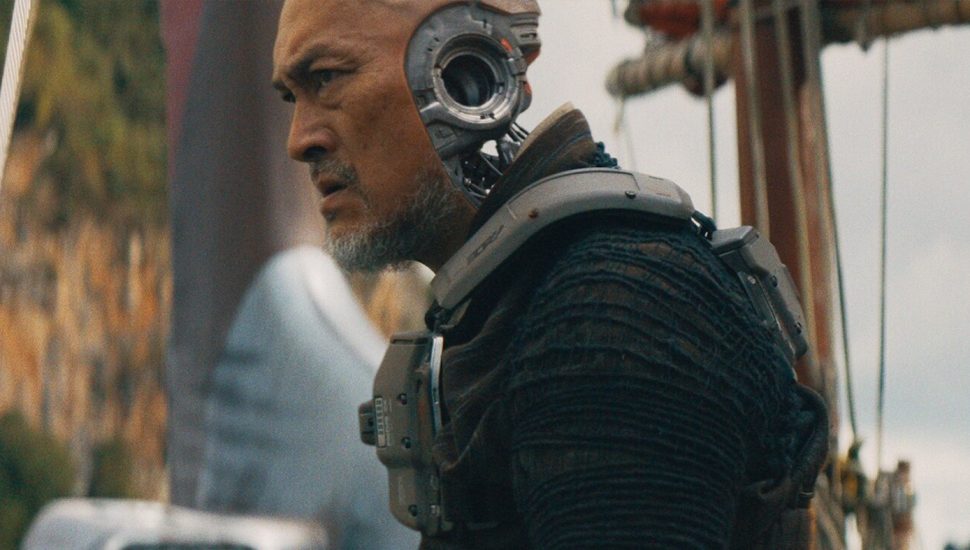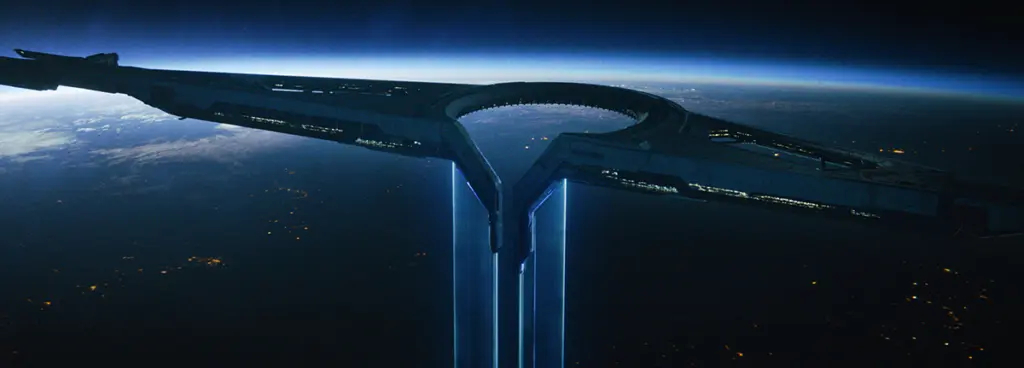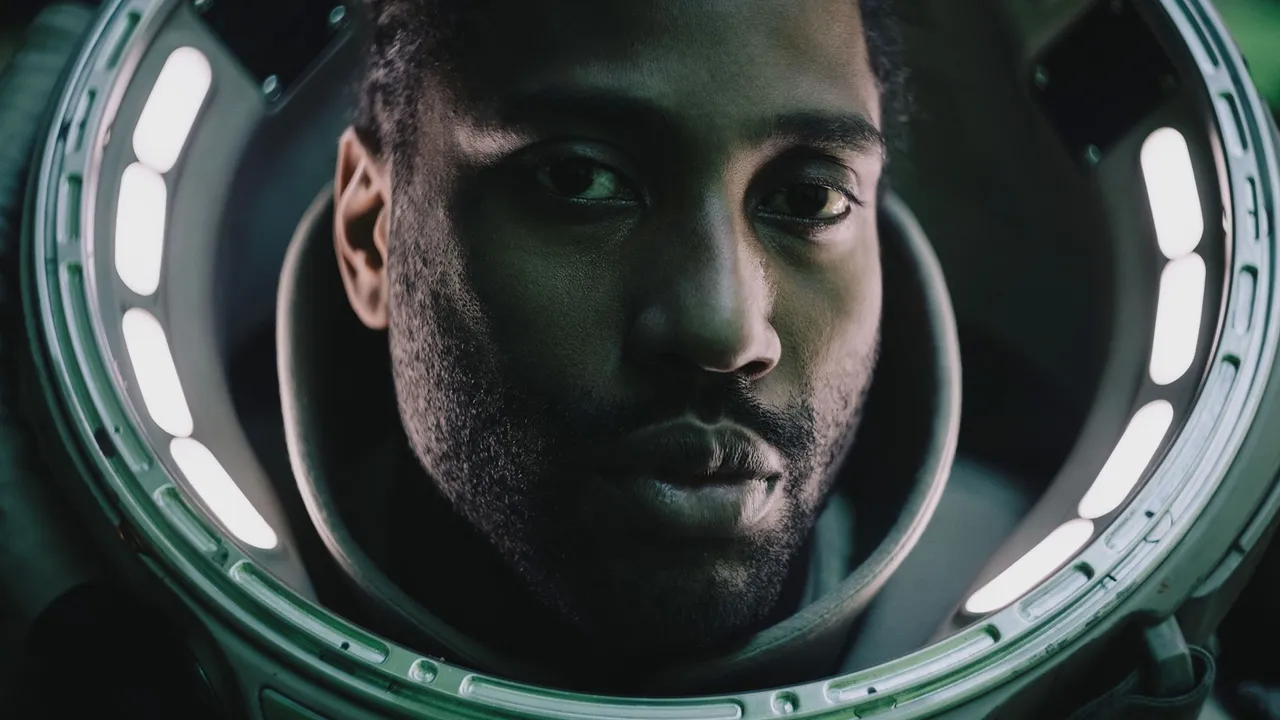The Creator Was Pretty Good
Written 55-C16 [2023-09-30], Edited 56-K07 [2025-05-03]
 Image credit: Regency Enterprises, eOne, Walt Disney Company
Image credit: Regency Enterprises, eOne, Walt Disney Company
There will be spoilers for The Creator and Rogue One: A Star Wars Story in this article.
Background
I knew basically nothing about The Creator when I walked in. I knew there would be robots walking in rice fields, I knew the director of Rogue One was involved, and I knew what form the “Alpha” weapon would appear as.
My expectations were not high. Rogue One was alright. It felt bleak, it had some nice scenery. For the first time ever we got A Star Wars Story that did not focus on the ever-present Skywalker family. On the other hand it still leaned heavily on the Star Wars lore and references. There were some parts of Rogue One’s plot that didn’t make sense, but I barely noticed.
Was the connection to Star Wars a restraint or a lifeline for the Rogue One director Gareth Edwards? It was a question that I would have never asked until I walked into the cinema.
There was almost no audience, maybe because I was in the VIP section on a Thursday night. Most advertisements and articles claim The Creator was supposed to be released a day after I saw it. I have no idea how that happened, so to convince myself I wasn’t hallucinating here’s the top half of my ticket.
 Image credit: Ratan Abraham Varghese
Image credit: Ratan Abraham Varghese
Aesthetics
The Creator has a varied and fascinating aesthetic, starting from the very first second. The movie is divided into chapters like Pulp Fiction - but the chapters just flow chronologically and flashbacks appear without any ceremony. The montage at the start, which establishes the alternate timeline, slips across decades and styles of filmmaking. The story proper features rice fields, backwaters, underground labs, flashy downtowns, a sweatshop, remote villages, temples with statues of robots tended to by robotic Buddhist monks, a basically normal highway, a spacecraft with the interior of a commercial airliner, and a space station. The Creator makes the planet Earth feel LARGE - compare this to the oddly claustrophobic Lightyear or the constant planet-hopping of Rogue One.
The Creator does not have the total, joyful chaos of Everything, Everywhere, All at Once or Spider-Man: Across the Spider-Verse. There’s a variety of settings but not a variety of emotion. The visuals of almost every scene communicate a sense of dread. Jokes exist, but this is not even remotely a comedy, it’s a grim story and the visuals reflect that.
The cartoons Alphie watches depict some of the events of the plot. So there were maybe five seconds of an original children’s cartoon made for this movie: very cute. The audience does not get a clear view of the show.
NOMAD is iconic, and so are the designs for the other technology in the world of The Creator. The robots, vehicles, and weapons all look great and, for the most part, original. It was honestly a bit shocking to see a regular jeep in the third act.
 Image credit: Regency Enterprises, eOne, Walt Disney Company
Image credit: Regency Enterprises, eOne, Walt Disney Company
 Image credit: Regency Enterprises, eOne, Walt Disney Company
Image credit: Regency Enterprises, eOne, Walt Disney Company
Some of the robots in this story look like vaguely human-shaped bits of metal and plastic. However some of the other robots are “simulants” with human-like faces and bodies. The “simulants” are still clearly robotic from the side, as they literally have nothing going on between the ears - and no human ears at all for that matter. The simulants look cool, and I suppose this matters for the emotional impact of the story. Yes, District 9 encouraged its audience to feel sympathy for human-sized cockroaches, but it’s important that in The Creator some robots look like specific humans.
Worldbuilding
 Image credit: Regency Enterprises, eOne, Walt Disney Company
Image credit: Regency Enterprises, eOne, Walt Disney Company
Speaking of robots, this is a story set in an alternate timeline where robotics is a lot more advanced. The alternate timeline is strongly implied by the montage at the start. The actual events of the story take place maybe 40 years after their timeline’s equivalent of the present.
Some plot-relevant bits of worldbuilding are established well. For example most plot-relevant sci-fi machinery are demonstrated visually. This is not to say that all the machinery are sensible. The Creator features an armored bomb with legs, a squad of robot cops who cannot detect human interlopers, and targeting lasers projecting human-sized crosshairs. The Creator has a lot of creative technology but some of the technology is blatantly impractical.
One core aspect of the premise is that AI are associated with humanoid robot bodies. The Creator does not feature much non-humanoid robots or disembodied AI, which seem to be everywhere in our timeline. The robot struggle for equality would be harder to sympathize with if they were AI which could endlessly transfer themselves from one quadrocopter drone to another. Weirdly enough, it is the human minds which are transferable in The Creator - a technology which could have lead to human immortality if it was explored more thoroughly.
The political and social environment of the story is vague. Why is “New Asia” even a country and where are the rest of the world powers? If I had to guess based on the one scene with a map of New Asia, I’d say that New Asia is probably a souped-up ASEAN and the rest of the world is too scared of NOMAD to assist. Speaking of NOMAD, it’s an iconic weapon but why is it so essential? Isn’t 1 NOMAD more vulnerable than a fleet of aircraft carriers and nuclear submarines? NOMAD’s uniqueness (it took 10 years to build) is what makes its destruction so important: the ending would be less poignant if the Americans could just build another.
The Creator’s worldbuilding is fine I guess. It is light on detail but what little details we get are believable enough. It’s less worldbuilding than James Cameron’s Avatar (which has an entire biosphere, language and history), but more fleshed out than the worldbuilding of Lightyear (a movie whose most shocking twist was a ham sandwich). My various nitpicks above were obvious in hindsight but the movie was compelling enough for me to avoid thinking about it. It is believable that in an alternate timeline, AI would be confined to humanoid robots, ASEAN would become New Asia and NOMAD would be a war-winning weapon. The only problem is, these details are unintuitive and conflict with the world we inhabit.
Plot & Character
 Image credit: Regency Enterprises, eOne, Walt Disney Company
Image credit: Regency Enterprises, eOne, Walt Disney Company
The actual physical events of The Creator aren’t that interesting. Characters run from place to place, but a lot of the running could have been avoided if the characters weren’t so secretive. Almost every location gets exploded or otherwise damaged. A lot of the events after Alphie’s capture are ridiculous.
There are many weird little stupidities. For instance how come the police put a hidden bomb in a box of ice cream, when they suspect the recipient has kidnapped a child? And did I mention the bomb with legs?
The most meaningful plot progression is not physical but emotional. Our protagonist Joshua starts out viewing AI as being emotionless and nonsentient, and killing them with no remorse. Over the course of his interaction with Alphie and his exploration of New Asia, he learns to respect the sentient robots around him. He risks his life for Alphie, who is practically his son, killing a “real” human to defend a robot who is “just programming”. After years of chasing his estranged lover Maya, Joshua has no choice but to either kill her or leave her in a coma. When recaptured by the Americans he is disgusted by them holding the attitudes he once had. Joshua is coerced into killing his “son” as well, but manages to escape the chains of his masters. He finally dies for the cause of robot liberation, but not before embracing a robot replica of his dead wife.
The physical story of The Creator is about blowing up a space station. The emotional story of The Creator is about love triumphing over hatred and discrimination - and that is the journey that actually connects all the scenes together.
The emotional story still isn’t as well done as District 9. The robots in The Creator are too cute and morally uncomplicated, except for that one nuclear explosion. The protagonist is also effectively looking out for his family. In comparison the “prawn” in District 9 are much easier to hate and the protagonist of District 9 risks everything for people he’s not related to.
Imagery, Themes and Social Commentary
 Image credit: Randall Munroe, xkcd.com
Image credit: Randall Munroe, xkcd.com
The Creator seems like a blatant Vietnam War allegory. The actions of the Americans in the film are reminiscent of that war: invading a southeast Asian country, airbombing villages, claiming to only want to kill a minority of people while in actuality murdering civilians and even children. The war lasts decades and the Americans have no clear exit plan. The goal is to eliminate all robots in New Asia forever, which is almost as difficult as killing all communists in Vietnam.
There is equally blatant religious imagery in this movie. The Creator features robotic Buddhist monks and funerals for robots. The consciousness-extracting machines literally give people a brief reincarnation. There are idols and statues of robots - and why not? If people today worship gods in the form of humans or animals, why not worship gods in the form of robots? Let’s not forget that Alphie activates her powers through meditation.
On top of the Buddhist (and Hindu?) imagery, there is also Christian imagery. Alphie is Nimrata’s only child, and was created specifically to save her species. Harun remarks that Nimrata could have built Alphie to hate humanity but made the opposite choice: Alphie was designed to turn the other cheek. Alphie’s status as a weapon is as misleading as Jesus' status as King of the Jews: Alphie is fundamentally on a mission of peace, not nation building. Both Alphie and Nimrata evade death: Alphie by going on standby and Nimrata using the brain uploading. Neither case exactly fits the Christian analogy perfectly, but they at least gesture towards the resurrection of Christ.
Joshua and Alphie’s discussions of the afterlife are another set of weird religious moments. Alphie claims that she and Joshua are alike in that neither of them are going to Heaven - but Joshua apparently never mentioned Hell. Assuming Hell exists, would a nonsentient robot go to Hell? And does Joshua believe he is going to Hell? Furthermore, when Joshua explains that Heaven is a place in the sky and the camera cuts to NOMAD, what does that imply about Heaven and about NOMAD? At the movie’s climax, Joshua claims he is going to Heaven and Alphie might join him one day: Joshua proceeds to die on NOMAD while kissing a simulant with the mind of Maya. Was that singular moment Heaven for Joshua?
Some people seem interested in the eerie similarities between the simulants and real-life deepfakes, or between robot sentience and real-life sentient-like behaviour from ChatGPT. However as discussed in the Worldbuilding section above, the AI of our world are not confined to humanoid bodies. Overcoming the differences between humans and AI will be conceptually tougher in our world, given that AIs run on large servers, can read and write incredibly quickly and can potentially travel across computer networks. Thus, the AIs of our world consume far more than 3 meals a day, can communicate with anyone anywhere with an internet connection, have more knowledge of random topics than an untrained human and are potentially immortal. Even if humans want to treat AI beings with respect, their strengths and weaknesses are so different from humans that the laws governing them might differ as well.
There’s something deeply ironic about the American military using a nuclear blast to justify their anti-AI stance, and enforcing that stance by creating the ominous NOMAD. It reminds me strongly of the above XKCD. An implicit moral of The Creator is that the problem with AI controlling nuclear weapons isn’t the AI, but the nuclear weapons. And that message can apply to many of the threats posed by AI. AI taking people’s jobs is a problem mainly because jobs are so limited and necessary for a good income. AI “stealing” art is a problem largely because our systems for rewarding good art and punishing thieves are currently really poor. AI exceeding human intelligence and killing all humans in the pursuit of maximizing paperclip production is… a problem that does not fit the model of AI in The Creator. The AI in The Creator are not just humanlike in form but also in intelligence. Much like the physical similarities with humans mentioned earlier, the intellectual similarity is necessary for the robot equality message to make sense.
Conclusions
The Creator is worth seeing for the aesthetic, worldbuilding and originality. It’s a breath of fresh air if you are tired of long-running franchises. Although the physical events of the plot are not that interesting, the emotional events are strong. It’s not necessarily an incredible life-changing experience, but it’s cool to look at and has something to say about the world.
Comments
What do you think?
The comment form accepts Markdown, with some limitations.
Your email, if provided, will not be shared with other readers.
After you press “Submit” a cookie is stored on your browser which identifies you to the comment system, and expires in 15 minutes. You can only edit or delete your comment while this cookie is active.
For more information, see this.